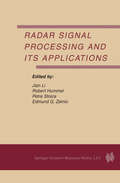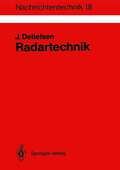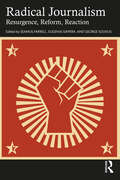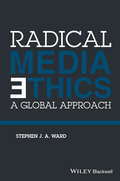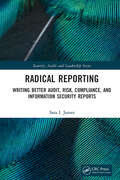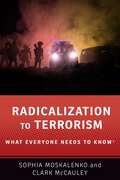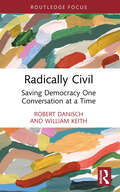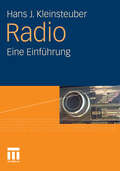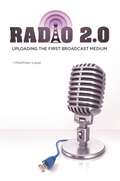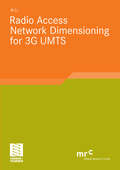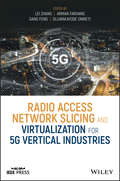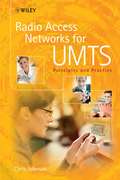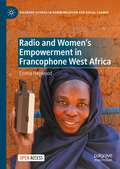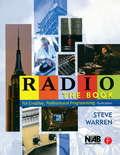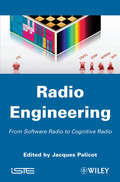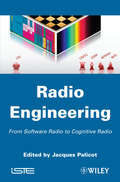- Table View
- List View
Radar Signal Processing and Its Applications
by Jian Jian Li Robert Hummel Petre Stoica Edmund G. ZelnioRadar Signal Processing and Its Applications brings together in one place important contributions and up-to-date research results in this fast-moving area. In twelve selected chapters, it describes the latest advances in architectures, design methods, and applications of radar signal processing. The contributors to this work were selected from the leading researchers and practitioners in the field. This work, originally published as Volume 14, Numbers 1-3 of the journal, Multidimensional Systems and Signal Processing, will be valuable to anyone working or researching in the field of radar signal processing. It serves as an excellent reference, providing insight into some of the most challenging issues being examined today.
Radartechnik: Grundlagen, Bauelemente, Verfahren, Anwendungen (Nachrichtentechnik #18)
by Jürgen DetlefsenRadical Journalism: Resurgence, Reform, Reaction
by Seamus Farrell Eugenia Siapera George SouvlisThis edited volume offers a state-of-the-art synthesis of the historical role of radical journalism, its present iterations, and plans for the future of a journalism that is committed to liberatory movements and politics. At a time of profound crisis and stagnation for mainstream journalism, radical journalism seems to be riding a wave. New outlets, including those – like Jacobin – with a global reach, have sprung up, presenting a new generation of unapologetically progressive publications with an emancipatory agenda. Understanding the role and place of radical journalism becomes even more urgent given the current political climate in a (post) pandemic world with heightened inequalities and intensified pauperisation. Drawing on contributions from leading academics, this collection considers: • How new outlets fit in the genealogy of (radical) journalism and what their flourishing can tell us about the present and future of emancipatory politics and the role of the radical journalist; • What these new forms and publications mean for mainstream journalism and its persisting problems of financial sustainability and professional journalistic labour; • Important challenges presented by, for example, the resurgence of fascism, authoritarianism and the mainstreaming of the far right; • Essential questions of what radical journalism looks like today, what forms it takes or should take, and what its future might be. Radical Journalism is recommended reading for advanced students and journalists working at the intersection of journalism, politics, and sociology.
Radical Journalism: Resurgence, Reform, Reaction
This edited volume offers a state-of-the-art synthesis of the historical role of radical journalism, its present iterations, and plans for the future of a journalism that is committed to liberatory movements and politics. At a time of profound crisis and stagnation for mainstream journalism, radical journalism seems to be riding a wave. New outlets, including those – like Jacobin – with a global reach, have sprung up, presenting a new generation of unapologetically progressive publications with an emancipatory agenda. Understanding the role and place of radical journalism becomes even more urgent given the current political climate in a (post) pandemic world with heightened inequalities and intensified pauperisation. Drawing on contributions from leading academics, this collection considers: • How new outlets fit in the genealogy of (radical) journalism and what their flourishing can tell us about the present and future of emancipatory politics and the role of the radical journalist; • What these new forms and publications mean for mainstream journalism and its persisting problems of financial sustainability and professional journalistic labour; • Important challenges presented by, for example, the resurgence of fascism, authoritarianism and the mainstreaming of the far right; • Essential questions of what radical journalism looks like today, what forms it takes or should take, and what its future might be. Radical Journalism is recommended reading for advanced students and journalists working at the intersection of journalism, politics, and sociology.
Radical Media Ethics: A Global Approach (Disruptions Ser.)
by Stephen J. WardRadical Media Ethics presents a series of innovative ethical principles and guidelines for members of the global online media community. Offers a comprehensive new way to think about media ethics in a new media era Provides guiding principles and values for practising responsible global media ethics Introduces one of the first codes of conduct for a journalism that is global in reach and impact Includes both philosophical considerations and practical elements in its establishment of new media ethics guidelines
Radical Media Ethics: A Global Approach
by Stephen J. WardRadical Media Ethics presents a series of innovative ethical principles and guidelines for members of the global online media community. Offers a comprehensive new way to think about media ethics in a new media era Provides guiding principles and values for practising responsible global media ethics Introduces one of the first codes of conduct for a journalism that is global in reach and impact Includes both philosophical considerations and practical elements in its establishment of new media ethics guidelines
Radical Reporting: Writing Better Audit, Risk, Compliance, and Information Security Reports (Security, Audit and Leadership Series)
by Sara I. JamesMost people dread writing reports; they also dread reading reports. What they don’t realize is that the techniques that make writing more readable make it more powerful. This is especially relevant for professionals in areas such as audit, risk, compliance, and information security. This small volume provides the tools and techniques needed to improve reports. It does so through addressing crucial concepts all too often overlooked in the familiar rush to perform tasks, complete projects, and meet deadlines. These concepts – the role of culture in communication; the link between logic and language; the importance of organizing thoughts before writing; and how to achieve clarity – may seem academic or theoretical. They’re not. Unless writers understand their own thoughts, actions, and objectives, they cannot hope to communicate them at all – let alone clearly.
Radical Reporting: Writing Better Audit, Risk, Compliance, and Information Security Reports (Security, Audit and Leadership Series)
by Sara I. JamesMost people dread writing reports; they also dread reading reports. What they don’t realize is that the techniques that make writing more readable make it more powerful. This is especially relevant for professionals in areas such as audit, risk, compliance, and information security. This small volume provides the tools and techniques needed to improve reports. It does so through addressing crucial concepts all too often overlooked in the familiar rush to perform tasks, complete projects, and meet deadlines. These concepts – the role of culture in communication; the link between logic and language; the importance of organizing thoughts before writing; and how to achieve clarity – may seem academic or theoretical. They’re not. Unless writers understand their own thoughts, actions, and objectives, they cannot hope to communicate them at all – let alone clearly.
Radicalization to Terrorism: What Everyone Needs to Know® (What Everyone Needs to Know)
by Sophia Moskalenko Clark McCauleyTerrorism and radicalization came to the forefront of news and politics in the US after the unforgettable attacks of September 11th, 2001. When George W. Bush famously asked "Why do they hate us?," the President echoed the confusion, anger and fear felt by millions of Americans, while also creating a politicized discourse that has come to characterize and obscure discussions of both phenomena in the media. Since then the American public has lived through a number of domestic attacks and threats, and watched international terrorist attacks from afar on television sets and computer screens. The anxiety and misinformation surrounding terrorism and radicalization are perhaps best detected in questions that have continued to recur in the last decade: "Are terrorists crazy?"; "Is there a profile of individuals likely to become terrorists?"; "Is it possible to prevent radicalization to terrorism?" Fortunately, in the two decades since 9/11, a significant body of research has emerged that can help provide definitive answers. As experts in the psychology of radicalization, Sophia Moskalenko and Clark McCauley propose twelve mechanisms that can move individuals, groups, and mass publics from political indifference to sympathy and support for terrorist violence. Radicalization to Terrorism: What Everyone Needs to Know synthesizes original and existing research to answer the questions raised after each new attack, including those committed by radicalized Americans. It offers a rigorously informed overview of the insight that will enable readers to see beyond the relentless news cycle to understand where terrorism comes from and how best to respond to it.
RADICALIZATION TO TERRORISM WENK C: What Everyone Needs to Know® (What Everyone Needs to Know)
by Clark McCauley Sophia MoskalenkoTerrorism and radicalization came to the forefront of news and politics in the US after the unforgettable attacks of September 11th, 2001. When George W. Bush famously asked "Why do they hate us?," the President echoed the confusion, anger and fear felt by millions of Americans, while also creating a politicized discourse that has come to characterize and obscure discussions of both phenomena in the media. Since then the American public has lived through a number of domestic attacks and threats, and watched international terrorist attacks from afar on television sets and computer screens. The anxiety and misinformation surrounding terrorism and radicalization are perhaps best detected in questions that have continued to recur in the last decade: "Are terrorists crazy?"; "Is there a profile of individuals likely to become terrorists?"; "Is it possible to prevent radicalization to terrorism?" Fortunately, in the two decades since 9/11, a significant body of research has emerged that can help provide definitive answers. As experts in the psychology of radicalization, Sophia Moskalenko and Clark McCauley propose twelve mechanisms that can move individuals, groups, and mass publics from political indifference to sympathy and support for terrorist violence. Radicalization to Terrorism: What Everyone Needs to Know synthesizes original and existing research to answer the questions raised after each new attack, including those committed by radicalized Americans. It offers a rigorously informed overview of the insight that will enable readers to see beyond the relentless news cycle to understand where terrorism comes from and how best to respond to it.
Radically Civil: Saving Democracy One Conversation at a Time (Routledge Research in Political Communication)
by Robert Danisch William KeithIf you feel like the world has gone to hell in a handbasket, you’re not alone. If you often feel there’s nothing you can do about it, you’re also not alone. Along with this increasing anger, fear, and frustration, much confusion still prevails on the appropriate communication practices for responding to difficult situations and improving our lives. Communication experts, Robert Danisch and William Keith, explain why and how we can practice radical civility in this practical guide to everyday “political” communication. This guide begins with examples of radical civility to show the potential of this kind of communication to change minds and bridge differences. The authors then unpack the three foundational principles of radical civility as useful theoretical tools for thinking throughout interactions with others in civic spaces. This is then followed by a three-step process for practicing radical civility drawing on research into active listening and its importance for creating connections, validating other views, and opening up possibilities for future conversation. The guide concludes with evidence-based communication practices and prescriptive recommendations for how to do each and show examples of each in action. Radically Civil: Saving Democracy One Conversation at a Time is a much-needed communication-based antidote to polarization, preparing students, researchers, and community leaders to be responsible participants in today’s society.
Radically Civil: Saving Democracy One Conversation at a Time (Routledge Research in Political Communication)
by Robert Danisch William KeithIf you feel like the world has gone to hell in a handbasket, you’re not alone. If you often feel there’s nothing you can do about it, you’re also not alone. Along with this increasing anger, fear, and frustration, much confusion still prevails on the appropriate communication practices for responding to difficult situations and improving our lives. Communication experts, Robert Danisch and William Keith, explain why and how we can practice radical civility in this practical guide to everyday “political” communication. This guide begins with examples of radical civility to show the potential of this kind of communication to change minds and bridge differences. The authors then unpack the three foundational principles of radical civility as useful theoretical tools for thinking throughout interactions with others in civic spaces. This is then followed by a three-step process for practicing radical civility drawing on research into active listening and its importance for creating connections, validating other views, and opening up possibilities for future conversation. The guide concludes with evidence-based communication practices and prescriptive recommendations for how to do each and show examples of each in action. Radically Civil: Saving Democracy One Conversation at a Time is a much-needed communication-based antidote to polarization, preparing students, researchers, and community leaders to be responsible participants in today’s society.
Radio: Eine Einführung
by Hans J. KleinsteuberDas Buch ist als Einführung konzipiert, die einen umfassenden und interdisziplinären Überblick zum Phänomen Radio bietet. Radio ist das älteste der elektronischen Medien, vermag in der Nutzungsdauer mit dem Fernsehen zu konkurrieren, gleichwohl kommt es über die Rolle eines ´Nebenher´-Mediums selten hinaus. Dabei ist das Radio in unserem Leben omnipräsent, es ist ein besonders variationsreiches und anpassungsfähiges Medium, es besticht durch Flexibilität, Universalität und Globalität. So begegnen wir ihm als Formatradio, Kulturradio, Nachrichtensender, Bürgerradio, Campusradio etc.
Radio 2.0: Uploading the First Broadcast Medium
by Matthew LasarWelcome to the uncertain world of "Radio 2.0"—where podcasts, mobile streaming, and huge music databases are the new reality, as are tweeting deejays and Apple's Siri serving as music announcer—and understand the exciting status this medium has, and will continue to have, in our digitally inclined society.How did popular radio in past decades—from President Franklin D. Roosevelt's "Fireside Chats" in the 1930s through Top 40 music and Rush Limbaugh's talk radio empire—shape American society? How did devices and systems like the iPhone, Pandora, and YouTube turn the radio industry upside-down? Does radio still have a future, and if so, what will we want it to look like?Radio 2.0: Uploading the First Broadcast Medium covers the history and evolution of Internet radio, explaining what came before, where Internet radio came from, and where it is likely headed. It also gives readers a frame of reference by describing radio from its introduction to American audiences in the 1920s—a medium that brought people together through a common experience of the same broadcast—and shows how technologies like digital music and streaming music services put into question the very definition of "radio." By examining new radio and media technologies, the book explores an important societal trend: the shift of media toward individualized or personalized forms of consumption.
Radio 2.0: Uploading the First Broadcast Medium
by Matthew LasarWelcome to the uncertain world of "Radio 2.0"—where podcasts, mobile streaming, and huge music databases are the new reality, as are tweeting deejays and Apple's Siri serving as music announcer—and understand the exciting status this medium has, and will continue to have, in our digitally inclined society.How did popular radio in past decades—from President Franklin D. Roosevelt's "Fireside Chats" in the 1930s through Top 40 music and Rush Limbaugh's talk radio empire—shape American society? How did devices and systems like the iPhone, Pandora, and YouTube turn the radio industry upside-down? Does radio still have a future, and if so, what will we want it to look like?Radio 2.0: Uploading the First Broadcast Medium covers the history and evolution of Internet radio, explaining what came before, where Internet radio came from, and where it is likely headed. It also gives readers a frame of reference by describing radio from its introduction to American audiences in the 1920s—a medium that brought people together through a common experience of the same broadcast—and shows how technologies like digital music and streaming music services put into question the very definition of "radio." By examining new radio and media technologies, the book explores an important societal trend: the shift of media toward individualized or personalized forms of consumption.
Radio Access Network Dimensioning for 3G UMTS (Advanced Studies Mobile Research Center Bremen)
by Xi LiXi Li presents innovative analytical models and algorithms for the dimensioning of the 3G UMTS Radio Access Network (RAN). The proposed analytical models allow efficient and accurate dimensioning for different evolutions of UMTS radio access technologies.
Radio Access Network Slicing and Virtualization for 5G Vertical Industries (Wiley - IEEE)
by Lei ZhangLearn how radio access network (RAN) slicing allows 5G networks to adapt to a wide range of environments in this masterful resource Radio Access Network Slicing and Virtualization for 5G Vertical Industries provides readers with a comprehensive and authoritative examination of crucial topics in the field of radio access network (RAN) slicing. Learn from renowned experts as they detail how this technology supports and applies to various industrial sectors, including manufacturing, entertainment, public safety, public transport, healthcare, financial services, automotive, and energy utilities. Radio Access Network Slicing and Virtualization for 5G Vertical Industries explains how future wireless communication systems must be built to handle high degrees of heterogeneity, including different types of applications, device classes, physical environments, mobility levels, and carrier frequencies. The authors describe how RAN slicing can be utilized to adapt 5G technologies to such wide-ranging circumstances. The book covers a wide range of topics necessary to understand RAN slicing, including: Physical waveforms design Multiple service signals coexistence RAN slicing and virtualization Applications to 5G vertical industries in a variety of environments This book is perfect for telecom engineers and industry actors who wish to identify realistic and cost-effective concepts to support specific 5G verticals. It also belongs on the bookshelves of researchers, professors, doctoral, and postgraduate students who want to identify open issues and conduct further research.
Radio Access Network Slicing and Virtualization for 5G Vertical Industries (Wiley - IEEE)
by Lei Zhang Arman Farhang Gang Feng Oluwakayode OniretiLearn how radio access network (RAN) slicing allows 5G networks to adapt to a wide range of environments in this masterful resource Radio Access Network Slicing and Virtualization for 5G Vertical Industries provides readers with a comprehensive and authoritative examination of crucial topics in the field of radio access network (RAN) slicing. Learn from renowned experts as they detail how this technology supports and applies to various industrial sectors, including manufacturing, entertainment, public safety, public transport, healthcare, financial services, automotive, and energy utilities. Radio Access Network Slicing and Virtualization for 5G Vertical Industries explains how future wireless communication systems must be built to handle high degrees of heterogeneity, including different types of applications, device classes, physical environments, mobility levels, and carrier frequencies. The authors describe how RAN slicing can be utilized to adapt 5G technologies to such wide-ranging circumstances. The book covers a wide range of topics necessary to understand RAN slicing, including: Physical waveforms design Multiple service signals coexistence RAN slicing and virtualization Applications to 5G vertical industries in a variety of environments This book is perfect for telecom engineers and industry actors who wish to identify realistic and cost-effective concepts to support specific 5G verticals. It also belongs on the bookshelves of researchers, professors, doctoral, and postgraduate students who want to identify open issues and conduct further research.
Radio Access Networks for UMTS: Principles and Practice
by Chris JohnsonThis book provides a comprehensive description of Radio Access Networks for UMTS . The main content is based upon the release 6 version of the 3GPP specifications. Changes since the release 99 version are described while some of the new features from the release 7 version are introduced. Starting from the high-level network architecture, the first sections describe the flow of data between the network and end-user. This includes a dedicated chapter describing the Iub transport network. Detailed descriptions of both HSDPA and HSUPA reflect the increasing importance of efficient high data rate connections. Signalling procedures are described for speech, video and PS data connection establishment, SMS data transfer, soft handover and inter-system handover. The more practical subjects of link budgets and radio network planning are also addressed. More than 180 example log files reinforce the reader's understanding Summary bullet points allow rapid access to the most important information Focus upon how data is transferred between the network and end-user Dedicated chapters provide detailed descriptions of both HSDPA and HSUPA Step-by-step analysis of common signalling procedures Key radio network planning subjects addressed Radio Access Networks for UMTS is ideal for mobile telecommunications engineers working for equipment vendors, operators and regulators. It will also appeal to system designers, technical managers and students.
Radio and Women's Empowerment in Francophone West Africa (Palgrave Studies in Communication for Social Change)
by Emma HeywoodThis open access book breaks new ground by examining the significant role played by radio in empowering women in three Francophone West African countries: Mali, Niger and Burkina Faso.It examines the representation and perception of key themes broadcast by radio and associated with women’s empowerment in the three countries. Each chapter contextualises a specific topic in the country and then explores discrete aspects of radio’s provision. The topics covered in the chapters are women’s political engagement; women and finances; women and life within marriage; inheritance; women’s involvement in radio structures; and radio, internally displaced women, and trauma.Given the social, economic and political vulnerability and deteriorating security situation of the three countries, this book provides a timely and meaningful contribution to acknowledging and understanding the vital role of radio in women’s empowerment.
Radio: The Book
by Steve WarrenAs entertaining as it is educational, Radio: The Book is a must-have guide to success for anyone interested in a career in radio. Providing a wealth of information and relating his own personal experiences, veteran radio personality, Program Director and Programming Consultant Steve Warren shares trade secrets and industry know-how that would usually take years to accumulate through experience. An invaluable advantage over your competition, this "cheat-sheet" for the radio programmer includes practical advice regarding:·Radio as a career--from tips on getting started to job negotiations·Programming--talk radio and music, from format science to picking the hits·Relationships with listeners--everything from staying in touch with your audience to public image·Branding, marketing, and advertising the radio station·Research--music tests, audience analysis, ratings, and more·Practical information about management policies·Radio realities--information on rules and regulationsThis latest edition has been updated to include: ·Important updates on an ever-evolving field·Essential forms for radio station functions--production orders, personnel files, absentee reports, PSA schedules, format clocks, remote schedule, and more.to be accompanied by an on-line section of electronic forms for convenience·Ideas for successfully programming in new radio formats like satellite, internet, and cableIn such a competitive industry where formal training can be hard to come by, Radio: The Book, 4e, is a short-cut to the fast track for current and future programmers and program directors. With an active radio broadcast career that is still exploring new ideas following s more than forty years at some of America's most prestigious radio stations (including WNBC, WHN, WNEW, and CBS radio), Steve Warren is more than qualified to mentor readers. Steve has competed successfully in all music formats from Easy Listening to Country to Top 40 to Oldies, always putting the listener first and now, putting you first.
Radio: The Book
by Steve WarrenAs entertaining as it is educational, Radio: The Book is a must-have guide to success for anyone interested in a career in radio. Providing a wealth of information and relating his own personal experiences, veteran radio personality, Program Director and Programming Consultant Steve Warren shares trade secrets and industry know-how that would usually take years to accumulate through experience. An invaluable advantage over your competition, this "cheat-sheet" for the radio programmer includes practical advice regarding:·Radio as a career--from tips on getting started to job negotiations·Programming--talk radio and music, from format science to picking the hits·Relationships with listeners--everything from staying in touch with your audience to public image·Branding, marketing, and advertising the radio station·Research--music tests, audience analysis, ratings, and more·Practical information about management policies·Radio realities--information on rules and regulationsThis latest edition has been updated to include: ·Important updates on an ever-evolving field·Essential forms for radio station functions--production orders, personnel files, absentee reports, PSA schedules, format clocks, remote schedule, and more.to be accompanied by an on-line section of electronic forms for convenience·Ideas for successfully programming in new radio formats like satellite, internet, and cableIn such a competitive industry where formal training can be hard to come by, Radio: The Book, 4e, is a short-cut to the fast track for current and future programmers and program directors. With an active radio broadcast career that is still exploring new ideas following s more than forty years at some of America's most prestigious radio stations (including WNBC, WHN, WNEW, and CBS radio), Steve Warren is more than qualified to mentor readers. Steve has competed successfully in all music formats from Easy Listening to Country to Top 40 to Oldies, always putting the listener first and now, putting you first.
Radio Design in Nanometer Technologies
by Mohammed Ismail Delia R. De Llera GonzálezRadio Design in Nanometer Technologies is the first volume that looks at the integrated radio design problem as a "piece of a big puzzle", namely the entire chipset or single chip that builds an entire wireless system. This is the only way to successfully design radios to meet the stringent demands of today’s increasingly complex wireless systems.
Radio Engineering: From Software Radio to Cognitive Radio
by Jacques PalicotSoftware radio ideally provides the opportunity to communicate with any radio communication standard by modifying only the software, without any modification to hardware components. However, taking into account the static behavior of current communications protocols, the spectrum efficiency optimization, and flexibility, the radio domain has become an important factor. From this thinking appeared the cognitive radio paradigm. This evolution is today inescapable in the modern radio communication world. It provides an autonomous behavior to the equipment and therefore the adaptation of communication parameters to better match their needs. This collective work provides engineers, researchers and radio designers with the necessary information from mathematical analysis and hardware architectures to design methodology and tools, running platforms and standardization in order to understand this new cognitive radio domain.
Radio Engineering: From Software Radio to Cognitive Radio (Lecture Notes Of The Institute For Computer Sciences, Social Informatics And Telecommunications Engineering Ser. #172)
by Jacques Palicot Pierre‐Noël FavennecSoftware radio ideally provides the opportunity to communicate with any radio communication standard by modifying only the software, without any modification to hardware components. However, taking into account the static behavior of current communications protocols, the spectrum efficiency optimization, and flexibility, the radio domain has become an important factor. From this thinking appeared the cognitive radio paradigm. This evolution is today inescapable in the modern radio communication world. It provides an autonomous behavior to the equipment and therefore the adaptation of communication parameters to better match their needs. This collective work provides engineers, researchers and radio designers with the necessary information from mathematical analysis and hardware architectures to design methodology and tools, running platforms and standardization in order to understand this new cognitive radio domain.
